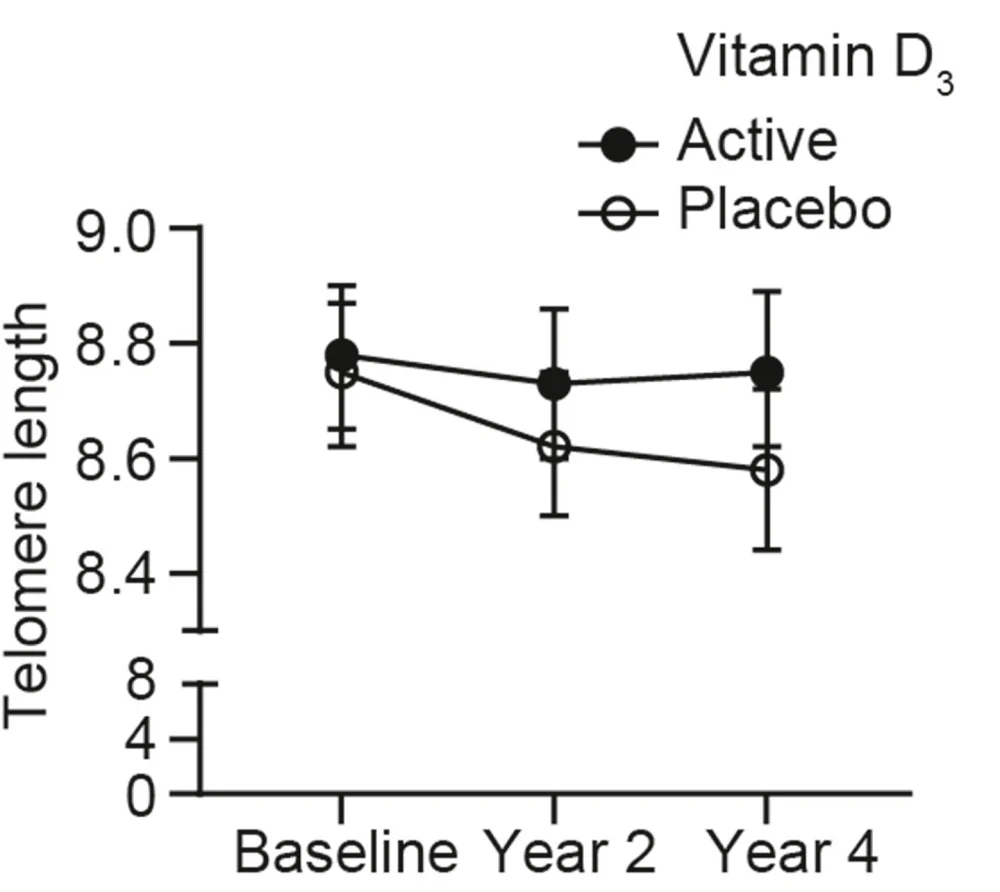A sub-study, which was part of the large-scale VITAL trial, determined that vitamin D supplementation slows telomere attrition in leukocytes almost to a halt. This could have real-life clinical implications [1].
The chromosome guardians
Attrition of telomeres, repetitive sequences that cap chromosomes, is one of the original hallmarks of aging. Our cells’ replication machinery does not copy the last few base pairs at chromosomes’ ends. These telomeres act as “surplus” DNA that does not contain valuable information and can be sacrificed. This also means that with each division, telomeres become shorter, which can eventually trigger cellular senescence. Previous research has found that telomere attrition in leukocytes, such as T cells, can predict chronic disease and mortality [2].

Read More
The attrition of attrition
A new study co-led by researchers at Mass General Brigham and the Medical College of Georgia has its roots in the VITAL trial, a large, nationwide, randomized, double-blind, placebo-controlled study that tested daily supplementation with vitamin D₃ (2 000 IU) and/or marine omega-3 fatty acids (1 g fish oil) for primary prevention of cancer and cardiovascular disease. VITAL lasted for five years and enrolled almost 26,000 US females and males aged at least 50 years.
VITAL already yielded some impressive results, showing statistically significant reductions in cancer mortality, the incidence of autoimmune decease, and circulating C-reactive protein levels (a marker of inflammation) in people who took vitamin D.
This new sub-study included slightly more than one thousand VITAL participants who had had their leukocyte telomere length measured at least twice during the study. At baseline, the mean leukocyte telomere length (LTL) was 8,700 base pairs, and the mean LTL loss in the placebo group was 160 base pairs over four years.
Vitamin D abrogated LTL loss almost completely, bringing it down to just about 20 base pairs over four years on average. Omega-3 supplementation did not significantly affect any outcome. While impressive, these results were just barely statistically significant because of the overall slow LTL loss and the limitations of current methods of measuring telomere length. No clinical outcomes were measured.
The association remained robust even after accounting for key demographic, behavioral, and cardiometabolic treatment variables. Those included age, sex, race, body-mass index (BMI), smoking status, hypertension medication use, diabetes, and high cholesterol.
“VITAL is the first large-scale and long-term randomized trial to show that vitamin D supplements protect telomeres and preserve telomere length,” said co-author JoAnn Manson, MD, principal investigator of VITAL and chief of the Division of Preventive Medicine at Brigham and Women’s Hospital. “This is of particular interest because VITAL had also shown the benefits of vitamin D in reducing inflammation and lowering risks of selected chronic diseases of aging, such as advanced cancer and autoimmune disease.”

It’s the shortest telomere that counts
These results require some unpacking. While the average annual LTL loss of 40 base pairs seems minuscule compared to a baseline LTL of 8,700, it might still be clinically significant because of the way cellular senescence works.
It’s the single most-eroded telomere in a cell that triggers the DNA damage response and pushes the cell into senescence. Once that “sentinel” telomere falls below a critical length, the cell stops dividing, regardless of how long all the others are [3]. A small shift in the mean LTL of about 40 base pairs per year might be a sign of a steady increase in the fraction of critically short telomeres across the cell population, increasing the probability that any given cell will cross that threshold.
Faster rates of LTL attrition in adults predict higher risks of adverse events even after adjusting for lifestyle and inflammation markers. Those epidemiological associations indicate that even small differences in attrition rate carry real-world health implications.
“Our findings suggest that targeted vitamin D supplementation may be a promising strategy to counter a biological aging process, although further research is warranted,” said Haidong Zhu, Ph.D., first author of the report and a molecular geneticist at the Medical College of Georgia, Augusta University.
Literature
[1] Zhu, H., et al. (2025). Vitamin D₃ and marine omega-3 fatty acids supplementation and leukocyte telomere length: 4-year findings from the VITAL randomized controlled trial. The American Journal of Clinical Nutrition, 0(0), 000–000.
[2] Epel, E. S., Merkin, S. S., Cawthon, R., Blackburn, E. H., Adler, N. E., Pletcher, M. J., & Seeman, T. E. (2008). The rate of leukocyte telomere shortening predicts mortality from cardiovascular disease in elderly men. Aging (Albany NY), 1(1), 81.
[3] Berardi, P., Martinez-Fernandez, V., Rat, A., Rosas Bringas, F. R., Jolivet, P., Langston, R., … & Teixeira, M. T. (2025). The shortest telomere in telomerase-negative cells triggers replicative senescence at a critical threshold length and also fuels genomic instability. bioRxiv, 2025-01.








































